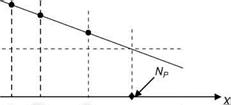A9 NEUTRAL AND MANEUVER POINTS
Neutral and maneuver points are important longitudinal stability parameters, which critically determine the aft CG limit of an aircraft. Since these parameters are a function of speed, AOA, external store configuration, control surface deployment (slats), etc., extensive flight tests are conducted to accurately determine these critical stability parameters. Existing methods based on steady-state trim flights turn out to be time-consuming and are error-prone because the results are dependent on air data and aircraft weight. An alternative approach, based on system theoretic concepts, is to estimate aircraft longitudinal static and dynamic stability from flight dynamic maneuvers in terms of neutral and maneuver points. In this procedure, the stability information is extracted from the short-period dynamic response of the aircraft, which leads to substantial reduction in flight test time compared with the conventional steady-state flight tests. Since this method does not use air data information or mass/inertia data, the resulting estimates of neutral and maneuver points are generally more accurate [9]. The neutral point is related to short-period static stability parameter Ma and hence the natural frequency (see Chapter 4). We estimate Ma values (using the parameter-estimation method) from short-period maneuver flight data of an aircraft, flying it for different CG positions (minimum three), and then plot with respect to CG, and extend this line to the x-axis. The point on the x-axis when this line passes through ‘‘zero’’ on the y-axis is the neutral point (see Figure A10). The distance between the neutral point NP and the actual CG position is called the static margin and when this margin is zero, the aircraft has neutral stability.
![]()

![]()
![]()
![]()
![]()
 Ma
Ma
|
|













